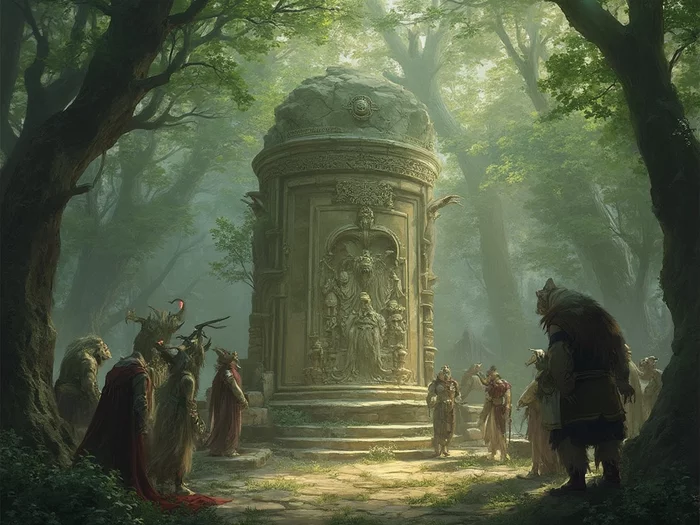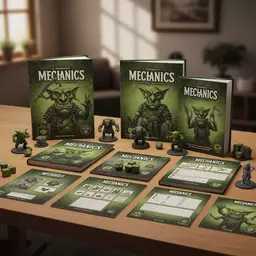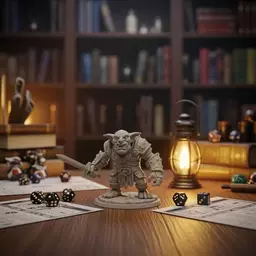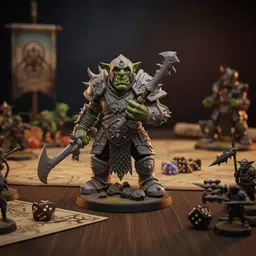Supreme Deity
Maglubiyet
God of War & Leadership, ultimate authority.
Don't miss out on the latest goblin lore, game mechanics, and homebrew stats. Subscribe to the Goblin Game Guide newsletter!
Posted on: 2025-10-12
By: Lorian Fableweaver
Have you ever wondered how goblinoid deities shape the rich tapestry of their culture? Delving into the world of goblinoid religion not only enhances gameplay but also opens doors to captivating storytelling possibilities!
An overview of the structure and the primary gods within goblinoid religion.
Maglubiyet
God of War & Leadership, ultimate authority.
Mork & Gork
Twin Gods of Cunning & Chaos, significant influence.
Anumilu, Suenanna
Balance of nature, trickery; crucial for specific rituals.
Welcome to the enchanting world of goblinoid religion! Understanding the significance of religion in goblinoid culture is crucial for anyone looking to dive deeper into the lore of these fascinating creatures. From their vibrant ceremonies to their quirky deities, religion stitches together the very fabric of goblin society, influencing everything from social order to daily life.
At Goblin Game Guide, we believe that getting a grip on the essence of goblinoid beliefs not only enriches gameplay but opens a treasure chest of storytelling opportunities. Have you ever thought about how a simple goblin deity could shape an entire campaign? Let’s unpack this together!
The heart of goblinoid culture beats strongly within their religious practices. For goblins, religion is not just a set of beliefs; it’s a way of life! The divine influences their actions, alliances, and even their mischievous antics. Here are a few key aspects that highlight the essence of goblinoid religion:
These elements create a vibrant tapestry of goblinoid spirituality, making it essential for gamers and dungeon masters to weave these beliefs into their narratives. By doing so, we can enhance the authenticity of our characters and campaigns!
Now, let's take a closer look at the core deities that make up the goblin pantheon! Each god plays a unique role, influencing various aspects of goblin life and culture. Understanding their significance is vital for any adventurer or storyteller looking to fully grasp the goblin experience:
These deities reflect the diverse traits and values within goblinoid society, making their stories rich and compelling. Exploring their myths and attributes can lead to fascinating insights for both gameplay and storytelling!
In the goblin pantheon, a clear hierarchy exists, reflecting the different roles and responsibilities of each deity. Understanding this structure helps in grasping how goblins interact with their gods and each other. Generally, the hierarchy can be broken down as follows:
This hierarchy not only shapes goblin worship but also influences the social dynamics within goblin tribes. By recognizing these roles, you can enhance your campaigns with authentic goblinoid interactions and conflicts!
Here are some common questions about goblinoid religion and their pantheon:
To truly bring goblinoid deities to life in your campaigns, consider incorporating unique rituals that reflect their characteristics. For instance, a ritual for Suenanna might involve a chaotic game of chance, where players must navigate unexpected outcomes that mirror the goddess's trickster nature. This not only adds depth to your storytelling but also engages players in a memorable way!
As we draw our exploration of the goblin pantheon to a close, it’s essential to reflect on the impact of goblinoid religion not only on gaming but also on storytelling and worldbuilding. Understanding the myths, deities, and cultural practices of goblins adds layers of depth to our adventures, enriching both the gameplay experience and narrative development. Imagine crafting a campaign where players must negotiate with a goblin shaman or partake in a ritual that honors Maglubiyet, the God of War!
Diving deep into the lore and beliefs of goblins provides valuable context that can transform a standard quest into a memorable journey. With this knowledge, you can weave engaging narratives that resonate with players, allowing them to appreciate the whimsical yet serious nature of goblin culture!
Why should we invest time in learning about goblin myths? Here are a few reasons:
By delving into these aspects, you foster a deeper connection to the characters and their motivations, which is essential for a fulfilling gaming experience.
If you're eager to expand your knowledge of goblinoid religion, here are some recommended materials:
These resources are perfect for enhancing your understanding and providing inspiration for your storytelling adventures!
Art and music play pivotal roles in goblinoid culture, serving as vital expressions of their faith. Goblins often create vibrant tapestries and intricate carvings that depict their deities and sacred events. These artworks are not just decoration; they convey deep spiritual significance and connect goblins to their gods.
Similarly, sacred music is integral to goblinoid rituals, often filled with lively rhythms and chants that invoke the spirits of their pantheon. These communal activities help strengthen social bonds and reinforce their cultural identity, making each gathering an important event!
So, are you ready to embark on your own adventure into the goblin pantheon? I encourage you to explore these rich goblinoid elements and incorporate them into your gaming sessions. Whether you’re a dungeon master crafting epic quests or a player seeking a unique character background, the world of goblins offers endless creative possibilities. Remember, at Goblin Game Guide, we’re here to support you in your journey, providing insights and resources to enrich your gaming experience!
Here is a quick recap of the important points discussed in the article:

 Curious about how the quirky mechanics of goblins can elevate your gaming experience? Unleash the fu
Curious about how the quirky mechanics of goblins can elevate your gaming experience? Unleash the fu
 As you embark on your homebrew journey, the balance of goblin stats can make or break your gaming ex
As you embark on your homebrew journey, the balance of goblin stats can make or break your gaming ex
 Have you ever considered how the smallest creatures can wield the greatest potential? When it comes
Have you ever considered how the smallest creatures can wield the greatest potential? When it comes